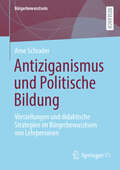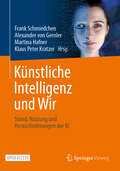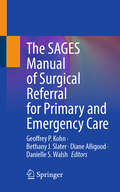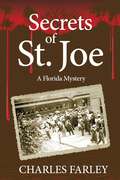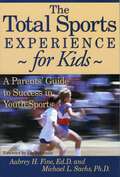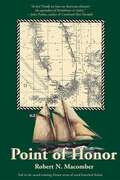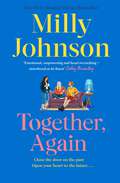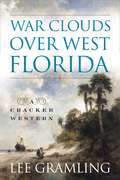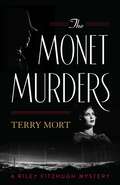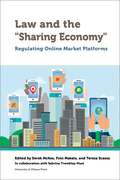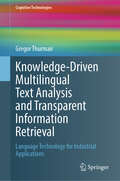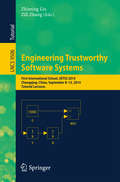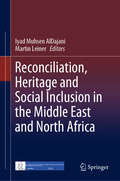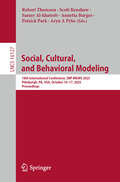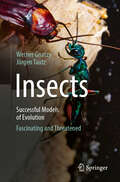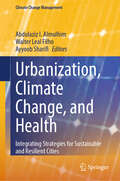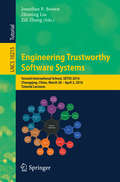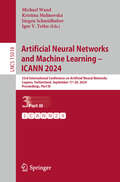- Table View
- List View
Antiziganismus und Politische Bildung: Vorstellungen und didaktische Strategien im Bürgerbewusstsein von Lehrpersonen (Bürgerbewusstsein)
by Arne SchraderIn diesem Buch wird die Relevanz, Wahrnehmung und didaktische Verarbeitung von Antiziganismus im schulischen Kontext aus politikdidaktischer Perspektive untersucht. Antiziganismus, verstanden als tief verwurzelte Form der rassistischen Ausgrenzung gegenüber als „Zigeuner&“ markierten Menschen, verbleibt trotz alarmierender Befunde aus etwa Einstellungsforschung und zivilgesellschaftlichen Monitoringstellen im Bildungsdiskurs weitgehend randständig. Forschungen diverser disziplinärer Zugänge zeigen, dass antiziganistische Ressentiments in der deutschen Gesellschaft konstant verankert sind und sich auch im schulischen Alltag niederschlagen. Ziel der Arbeit ist es daher, die subjektiven Vorstellungen und berufsbezogenen Überzeugungen von Lehrpersonen an allgemeinbildenden Schulen zu Antiziganismus zu analysieren, um daraus Rückschlüsse auf didaktische Handlungsmöglichkeiten sowie die Entwicklung eines antiziganismuskritischen Bildungsansatzes zu ziehen. Im Zentrum steht dabei ein subjektorientierter Zugang, der von den individuellen Konzepten und professionellen Deutungsmustern der Lehrpersonen ausgeht.
Künstliche Intelligenz und Wir: Stand, Nutzung und Herausforderungen der KI
by Frank Schmiedchen Alexander Von Gernler Martina Hafner Klaus Peter KratzerDieses Open Access Buch bietet einen umfassenden Überblick über den aktuellen Stand der Technikentwicklung und die zukünftigen Möglichkeiten der Künstlichen Intelligenz (KI). Experten aus verschiedenen Disziplinen beleuchten die vielfältigen Aspekte der KI, von technischen Grundlagen über ethische Fragestellungen bis hin zu gesellschaftlichen und wirtschaftlichen Auswirkungen. Das Buch wendet sich an Lehrende und Lernende an deutschsprachigen Hochschulen und kann als Lehrbuch außerhalb der Informatik verwendet werden. Zu den Herausgebern gehören der Wirtschaftswissenschaftler Frank Schmiedchen, der seit 2017 die Studiengruppe Technikfolgenabschätzung der Digitalisierung der Vereinigung Deutscher Wissenschaftler leitet, der ehemalige Vizepräsident der Gesellschaft für Informatik Alexander von Gernler, der Abteilungsleiter Research und Innovation der genua GmbH ist, die Wirtschaftsinformatikerin Martina Hafner, die bei der genua GmbH als Innovationsmanagerin arbeitet, und Klaus Peter Kratzer, der Professor für Informatik an der Technischen Hochschule Ulm war.
Scientific Writing and Publication Strategies for Oral Health Professionals
by Rodrigo Mariño Sergio E. Uribe Ebingen Villavicencio-CaparóThis is the first-known book on research writing and scientific publication strategies specifically aimed at oral health professionals. Scientific writing makes it possible for the knowledge acquired from research to be evaluated by peers, circulated and made available for broad public consumption. This process also serves as a means of evidence evaluation by the wider society. This book focuses on how to present and publish research evidence, detailing in an accessible way how this requires not only research skills and expertise, but also a good command of scientific language, communication and presentation. This manual guides readers on the acquisition of the knowledge, skills, and competencies to communicate the results of scientific research accurately, effectively and clearly. This manual also provides the practical skills of how and where to publish a range of formats (poster, manuscript, reports), including submission to peer review and responding to criticism and reviewers' feedback. Although the book focuses on oral health professionals, its content is highly relevant to all health professionals. Among the topics covered are: Document Taxonomy: research protocol, grant proposal, manuscript, conference presentations Publication Types: Diversifying Scholarly Communication Enhancing Research Transparency: Open Protocols, Access, and FAIR Data Preparation of an Original Article Article Submission Strategy A Guide to Successful Conference Presentations Navigating the Peer Review Process Scientific Writing and Publication Strategies for Oral Health Professionals offers guidance on how to acquire the skills required to write scientific articles. Readers include motivated health professionals, research scholars, academics and faculty members, both undergraduate and postgraduate students, editors of scientific journals in the health area, supervisors of higher degree students, and trainers of oral health professionals of various disciplines interested in research and the publication of research results in high-impact scientific journals.
The SAGES Manual of Surgical Referral for Primary and Emergency Care
by Danielle S. Walsh Geoffrey P. Kohn Bethany J. Slater Diane AlligoodPrimary care and emergency room clinicians manage a complex array of disorders and are commonly the first to encounter a surgical or potentially surgical disorder. The purpose of this manual is to assist non-surgeons in determining when a patient should or need not be referred for surgical assessment. This manual includes referral guidance on surgical disorders commonly cared for by adult and pediatric general surgeons with a focus on the thoracoabdominal domain. Chapters describe patient history and clinical examination findings relevant to the probable diagnosis. Guidance is then provided on the evaluation of these patients to include studies that should be performed prior to referral as opposed to those that should be reserved for after surgical assessment. Interpretation of relevant imaging and laboratory assessments as it relates to the decision to refer or not refer to a surgeon is included, and literature and guidelines, where available, are incorporated. Additionally, alternatives to surgical referral are provided when relevant. All chapters are written by experts in their fields and include the most up-to-date scientific and clinical information.
Première Rue (Série fantasy cosy de Harbor View)
by Jan Coffey May McGoldrickBienvenue à Harbor View, où les ragots circulent vite, les fantômes s'éternisent, et où aucun secret ne reste caché pour toujours... Lorsque Skye Randall revient dans sa pittoresque ville natale de Nouvelle-Angleterre après la mort soudaine de sa mère, elle emmène avec elle sa fille de quinze ans, des projets pour deux semaines et absolument aucune intention de s'installer. Elle est venue régler la succession, liquider les antiquités et retourner en Californie sauver son mariage en péril. Simple, non ? Que nenni. Harbor View en a décidé autrement. Ce charmant village côtier regorge de voisins indiscrets, d'un air marin salé aux légers effluves magiques, et de deux fantômes têtus qui hantent la librairie et le magasin d'antiquités donnant sur First Street. Skye a gardé secret leur existence vis-à-vis de sa fille, mais quand d'étranges événements suggèrent que la mort de Clare n'était pas qu'un simple accident tragique, elle réalise qu'elle aura besoin de toute l'aide disponible — même si une partie provient de l'au-delà. Tandis que Skye et Ocean affrontent le deuil, les secrets familiaux et toute une série de péripéties surnaturelles, elles découvrent que certains héritages méritent qu'on se batte pour eux. Et à Harbor View, le passé ne se contente pas de frapper poliment à la porte — il fait irruption sans prévenir. Dans une ville où les secrets s'attardent et où les esprits refusent de se taire, deux semaines peuvent tout bouleverser ! Touchant, drôle et empreint de magie maritime, First Street est le premier tome de la série Harbor View Cozy Fantasy... où les liens familiaux, l'aide fantomatique et une pointe de malice font toute la différence.
Bogus U.
by Paul M. LevittWhen the classical scholar Phineas Ort, Bogus U.&’s first choice for president, disappears, the search committee decides to recruit a hit man to keep the fractious faculty in line. Phineas has been abducted by the Robaccia gang, who aim to install their own candidate in the president&’s office to cash in on Bogus U.&’s well-known corruption.Christy Mahon, a former member of the Robaccia gang, now on the lam for having crossed its boss, Brooklyn Benny, has landed a job at Bogus U. as a janitor. Listening through a heating vent, he overhears the search committee&’s deliberations and decides to interview for the job, which he ultimately lands in a funny and subversive chain of events.Laura Favoloso, who has her own ties to the mob, works at Bogus U. and provides Christy with an insider&’s view of its inner workings and lower depths. Under Laura&’s influence and tutelage, Christy reluctantly begins to transform into a new man, and tries to institute rigorous academic standards, raising the ire and exciting the violent tendencies of the student population. But the student body is not the only quarter from which Christy must guard himself from mortal harm—a hit has been ordered on Christy, and he must use his old street smarts as well as his newly acquired political savvy to survive and protect his legacy.
Secrets of St. Joe
by Charles FarleyThird in the mystery Secrets trilogy set in the Florida Panhandle, featuring Old Doc Berber as sleuth. Someone in the tiny Gulf Coast village of Port St. Joe, Florida is trying to murder Doc Berber and everyone he loves. When the doctor foolishly sets out to track down the revenge-crazed killer himself, he is forced to confront the most shameful secrets of the town, the murderer, . . . and himself.See all of the books in this series
First Fighter Ace: In the Cockpit with a World War II Fighter Pilot (Stackpole Military History Series)
by Stanislaw SkalskiStanisław Skalski was the top Polish fighter ace and the first Allied fighter ace of World War II. His combat career began on the war&’s very first day, September 1, 1939, and within two weeks, Skalski had achieved ace status, with six German kills to his credit. After Poland&’s surrender, Skalski and other Polish pilots ended up in England to join the Royal Air Force during the Battle of Britain. He later took command of the Polish Fighting Team, known as Skalski&’s Circus, which claimed twenty-six enemy aircraft shot down in a mere two months in North Africa. Skalski then became the first Pole to command an RAF squadron, which he led in Sicily and Italy until he took over a Polish fighter wing and saw action in France after D-Day. According to official tallies, he had scored some twenty aerial victories.
Our Favorite Melts & Wraps Recipes
by Gooseberry PatchSandwiches for lunch or supper...what could be easier? Our Favorite Melts & Wraps Recipes Cookbook has over 60 simple recipes for taste-tempting sandwiches, wraps and roll-ups for lunch, dinner, snacks and parties. Hearty fare like heavenly hot ham & cheese, patty melts and Italian sausage sandwiches. You'll love fun-to-eat chicken ranch quesadillas and pepperoni calzones...fireside reubens are perfect for your next campfire and the kids will love chili dog wraps! Warm and ooey-gooey or cool and crunchy...we love 'em all and you will too!
The Total Sports Experience for Kids: A Parent's Guide for Success in Youth Sports
by Michael L. Sachs Aubrey H. FineThis book explores the true meaning of achievement in sports: having fun, developing athletic and social skills, and nurturing a healthy, positive sense of self-esteem. Drs. Fine and Sachs offer practical, research-based advice that is bound to enrich the sports experience—as well as life outside of sports—for both children and adults.
Point of Honor (Honor Series)
by Robert N. MacomberRobert Macomber's Honor series of naval fiction follows the life and career of Peter Wake in the U.S. Navy during the tumultuous years from 1863 to 1901. Point of Honor is the second in the series and winner of the John Esten Cook Literary Award for Best Work in Southern Fiction.The year is 1864. Peter Wake, U.S.N., assisted by his indomitable Irish bosun, Sean Rork, is at the helm of the schooner St. James, a larger ship than his first command in At the Edge of Honor. Wake's remarkable ability to make things happen continues as he searches for army deserters in the Dry Tortugas, discovers an old nemesis during a standoff with the French Navy on the coast of Mexico, starts a drunken tavern riot in Key West, and confronts incompetent Federal army officers during an invasion of upper Florida.Along the way, Wake's personal life takes a new tack when he risks reputation for love by returning to the arms of his forbidden sweetheart, the daughter of a Confederate zealot. Key West provides a unique setting for them to prove that their love is strong enough to overcome the insanity of the war. And through it all, even when surrounded by the swirling confusion of danger and political intrigue, Peter Wake maintains his dedication to balance on the point of honor.
Together, Again: tears, laughter, joy and hope from the much-loved Sunday Times bestselling author
by Milly JohnsonTHE NEW MILLY JOHNSON NOVEL, THE HAPPIEST EVER AFTER, IS OUT NOW!Together again after years apart, can they find a new beginning? The brilliant novel full of laughter, love, tears and hope from the Sunday Times bestselling author Milly Johnson. 'This masterpiece honestly describes the strength and acceptance required to be a family. 5 STARS' ADELE PARKS, Book of the Month, Platinum magazine 'Darkness and light, complexity and humour, Milly has nailed the perfect cocktail for a compelling, page-turning read. Absolutely magnificent.' VERONICA HENRY &‘Emotional, empowering and heart-wrenching – sisterhood at its finest&’ CATHY BRAMLEY Sisters Jolene, Marsha and Annis have convened at their beautiful family home, Fox House, following the death of their mother, the tricky Eleanor Vamplew. Born seven years apart, the women are more strangers than sisters. Jolene, the eldest, is a successful romantic novelist who writes about beautiful relationships even though her own marriage to the handsome and charming Warren is complicated. Marsha, the neglected middle child, has put all of her energy into her work, hoping money will plug the gap in her life left by the man who broke her young heart. Annis is the renegade, who left home aged sixteen and never returned, not even for the death of their beloved father Julian. Until now. So when the sisters discover that their mother has left everything to Annis in her will, it undermines everything they thought they knew. Can saying their final goodbyes to Eleanor bring them together again?Together, Again is the story of truths uncovered and lies exposed, of secrets told – and kept. It is a novel about sister helping sister to heal from childhood scars and finding in each other support, forgiveness, courage and love. Your favourite authors love Milly Johnson: &‘Reading a Milly Johnson book is like spending time with a best friend – you always end up feeling better about the world. Written with genuine warmth and heart, they&’re an absolute treat&’ Lucy Diamond &‘Milly Johnson always delivers an absolutely cracking read&’ Katie Fforde &‘One of those novels that draws you in to its world and makes you wish you could be friends with Shay. A tantalising juicy tale full of twists and turns that kept me gripped. Warm, funny and moving. One to curl up with and devour&’ Ruth Jones &‘The feeling you get when you read a Milly Johnson book should be bottled and made available on the NHS&’ Debbie Johnson &‘Milly&’s writing is like getting a big hug with just the right amount of bite underneath&’ Jane Fallon
Caribbee
by Julian StockwinThe 14th volume in the popular high-seas nautical adventure series featuring naval hero Thomas Kydd. As the captain of the 32-gun frigate L'Aurore, Kydd is claimed by the Leeward Islands station, exchanging the harsh situation in South America for the warmth and delights of the Caribbean. It's a sea change for Kydd, who revisits the places and people that figured in his time as a young seaman. Some are nostalgic and pleasing, while others bring challenges of a personal nature. Even though Napoleon is triumphant on land back in Europe, Kydd and the others feel secure so far away in the Caribbean, making the most of running down prizes and sending off fat convoys of sugar to England. But, in a stroke of genius, Bonaparte finds a way to take revenge for Trafalgar, and Kydd is shocked out of complacency when an element from his past returns and he is accused of murder. In a stroke of irony, it is that same past that may just provide Kydd the means to clear his name.
War Clouds Over West Florida
by Lee GramlingJohn Thomas MacKenzie would much prefer to spend his remaining years just "tending his garden" at his estate in Spanish Florida, surrounded by his two tall sons and his lovely daughter Rebecca (whom all but her father call Becky). Unfortunately, the Empire of Great Britain and the young United States intrude on his plans. The English hope to cause an Indian uprising and seize the Spanish colony as a base for an invasion of their 13 lost American colonies. Against his will, MacKenzie is drawn into the turmoil by an American naval lieutenant and his crew who have been secretly sent by their government to try to thwart the British scheme. As if that weren't trouble enough, they encounter in the process an old enemy of MacKenzie's, a former pirate known as Dread Jamie Tyrone. When Tyrone sees Becky it's love at first sight -- on Tyrone's part. He kidnaps the young woman and plans to spirit her away to Ireland where she will be forced to become his wife. A chase ensues by both land and sea as MacKenzie and a companion seek to rescue his daughter while the Americans hurry to warn the Spaniards of the danger from the British. A resolution finally occurs at sword point in the vast untamed wilderness of Spanish West Florida.
Monet Murders (The Riley Fitzhugh Novels)
by Terry MortHollywood, 1934. Prohibition is finally over, but there is still plenty of crime for an ambitious young private eye to investigate. Though he has a slightly checkered past, Riley Fitzhugh is well connected in the film industry and is hired by a major producer—whose lovely girlfriend has disappeared. He also is hired to recover a stolen Monet, a crime that results in two murders initially, with more to come. Along the way, Riley investigates the gambling ships anchored off LA, gets involved with the girlfriend of the gangster running one of the ships, and disposes of the body of a would-be actor who assaults Riley&’s girlfriend. He also meets an elegant English art history professor from UCLA who helps Riley authenticate several paintings and determine which ones are forgeries. Riley lives at the Garden of Allah Hotel, the favorite watering place of screenwriters, and he meets and unknowingly assists many of them with their plots. Incidentally, one of these gents, whose nom de plume is &“Hobey Baker,&” might actually be F. Scott Fitzgerald.
Law and the "Sharing Economy": Regulating Online Market Platforms (Law, Technology, and Media)
by Derek McKee, Finn Makela, and Teresa ScassaLa controverse entoure les plateformes d’économie de partage, partiellement en raison de leur impact économique. Certains secteurs subissent des contrecoups de manière plus aigüe : les chauffeurs d’Uber font concurrence aux chauffeurs de taxi, ou les hôtes Airbnb rivalisent avec les hôtels. Par ailleurs, Uber exacerberait l’emploi précaire et mal rémunéré tandis qu’Airbnb amplifierait la spéculation immobilière et entraînerait, à terme, une hausse du coût de location.On a tenté de réglementer ce type de plateformes, mais la technologie est telle qu’elle permet aux entreprises d’aisément contourner la réglementation conventionnelle, si bien que les accusations de « concurrence déloyale » fusent de toutes parts, provoquant une remise en question du cadre réglementaire. En effet, de telles plateformes viennent brouiller les cartes, confondant les distinctions convenues entre personnel et commercial, infrastructure et contenu, autonomie contractuelle et contrôle hiérarchique. Cette ambiguïté peut avoir d’importantes répercussions sur le bon fonctionnement de l’appareil réglementaire qui encadre les principes organisateurs du travail, de la concurrence, de l’impôt, de l’assurance, de l’information et de de l’interdiction de la discrimination, sans parler de la réglementation sectorielle spécialisée.Cinq thématiques sont abordées dans cet ouvrage : les technologies de la réglementation; la réglementation de la technologie; les lieux de la réglementation (du local au mondial); la réglementation des marchés; et la réglementation du travail. Les chapitres se conjuguent pour offrir une réflexion d’une gamme d’experts sur la jurisprudence traditionnelle que sur les approches théoriques qui informent et façonnent la réglementation de l’économie du partage.Publié en anglais.
Knowledge-Driven Multilingual Text Analysis and Transparent Information Retrieval: Language Technology for Industrial Applications (Cognitive Technologies)
by Gregor ThurmairThis book presents all components and knowledge sources required for Transparent Information Retrieval. Depending on the respective topic and taking care of their interoperability, both deep and shallow technology is used. The processing starts from the analysis of the text data and collects its results in a multilingual conceptual network, this way enabling Transparent Information Retrieval where users communicate with the system in their native language while the documents could be in a different language, transparent to the users. To do so, the author investigates all text analysis components required for multilingual indexing, starting from preparatory work like language and topic identification, continuing with sentence splitting and tokenization (including Chinese), and describing lexical analysis, also for multiword entries and Named Entities. Entries are then disambiguated both on syntactic (by a tagger) and semantic level (by multilingual word sense disambiguation). The analysis results are collected in a dynamic multilingual ConceptNet, which is an index structure extended by monolingual relations (like synonyms, or head-modifier links) as well as multilingual ones (translations). In addition to many European languages also Turkish, Arabic, Persian, and Chinese are treated. The book concludes with a description of components needed to build the required resources, like crawlers, bilingual term extraction, and tools for defaulting linguistic annotations. For each component, readers will find a technology overview, a discussion of its main challenges in computational treatment, a description of the technical solution selected, and evaluation information.
Engineering Trustworthy Software Systems: First International School, SETSS 2014, Chongqing, China, September 8-13, 2014. Tutorial Lectures (Lecture Notes in Computer Science #9506)
by Zhiming Liu Zili ZhangThis volume contains the lecture notes of the five courses and one seminar given at the School on Engineering Trustworthy Software Systems (SETSS 2014), held in September 2014 at Southwest University in Chongqing, China. The material is useful for postgraduate students, researchers, academics and industrial engineers who are interested in the theory and practice of methods and tools for the design and programming of trustworthy software systems. The common themes of the courses include the design and use of theories, techniques and tools for software specification and modeling, analysis and verification. The courses cover sequential programming, component- and object software, hybrid systems and cyber-physical systems with challenges of termination, security, safety, security, fault-tolerance and real-time requirements. The techniques include model checking, correctness by construction through refinement and model transformations, synthesis and computer algebra.
Reconciliation, Heritage and Social Inclusion in the Middle East and North Africa
by Martin Leiner Iyad Muhsen AlDajaniThis book, sponsored by the Academic Alliance for Reconciliation Studies in the Middle East and North Africa (AARMENA), focuses on peacebuilding, conflict transformation, and shifts toward approaching the reconciliation process as an inter-, trans- and multidisciplinary field. The research presented in the series focuses on the Middle East and North Africa, highlighting contributions by practitioners and scholars alike. This volume showcases research on Heritage, Reconciliation, and Social Inclusion in the Middle East and North Africa. It reflects various inter-, trans- and multidisciplinary approaches applied both theoretically and practically, and explores conflict transformation and transitional shifts towards peacebuilding and reconciliation in the MENA (Middle East and North Africa) region. The content is divided into five sections, the first of which examines the importance of reconciliation, peacebuilding, and social inclusion in contributions by experts in the field such as Martin Leiner, Wolfgang Dietrich, Mohammad Abu Nimer, Mohmmad Alshraideh and Iyad Aldajani. The second and third section explore digital humanities and the research sciences respectively, while the fourth turns to practices of heritage and reconciliation. The fifth section presents case studies on practices, conducted by expert researchers for heritage, reconciliation, and social inclusion in higher education.
Social, Cultural, and Behavioral Modeling: 18th International Conference, SBP-BRiMS 2025, Pittsburgh, PA, USA, October 14–17, 2025, Proceedings (Lecture Notes in Computer Science #16127)
by Robert Thomson Scott Renshaw Samer Al-Khateeb Annetta Burger Patrick Park Aryn A PykeThis volume contains the proceedings of the 18th International Conference on Social, Cultural, and Behavioral Modeling, SBP-BRiMS 2025, which took place in Pittsburgh, Pennsylvania, USA, in October 2025. The 23 papers presented in this volume were carefully reviewed and selected from 56 submissions. They are divided into the following themes: Advances in Tools and Theory; Data-Driven Approaches. Another focus of the conference is on understanding, predicting, and influencing human sociocultural behavior.
Insects - Successful Models of Evolution: Fascinating and Threatened
by Jürgen Tautz Werner GnatzyIn the course of evolution, insects have developed an almost unbelievable variety of shapes and functional sophistication. The design of their exoskeleton is so imaginative and unusual, often even bizarre, that one can only marvel. The fact that insects can find design solutions for any problem, no matter how special, makes them extremely successful. They have thus become crucial links in the complex networks of nature. Impressive macro photographs and informative scanning electron-optical images provide an insight into the wealth of forms, beauty and function of the six-legged creatures. Fascinating texts accompany the pictures and explain, among other things, how the great diving beetle uses vertebrate hormones as knock-out drops when attacked by fish, the pine moth beetle locates distant forest fires, the bombardier beetle emits pulsed explosions with its firing apparatus or the blue butterfly caterpillar glamours ants. Insects play a crucial role in the ecosystems of our planet. Man-made environmental destruction is interfering with these cycles in a sensitive way. This endangers the survival of insects, with dramatic consequences for us humans as well.
Urbanization, Climate Change, and Health: Integrating Strategies for Sustainable and Resilient Cities (Climate Change Management)
by Walter Leal Filho Ayyoob Sharifi Abdulaziz I. AlmulhimThis book seeks to provide a comprehensive examination of the critical intersection between urbanization, climate change, and public health. As urban areas expand and face increasing pressures from environmental changes and population growth, there is a growing need for integrated approaches that address these intertwined challenges. This book aims to explore how urban planning, public health, and climate resilience can be aligned to create cities that are not only sustainable but also capable of supporting the well-being of their residents. Designed as a vital resource for urban planners, public health professionals, policymakers, environmentalists, and academics, this book offers insights into strategies for fostering urban environments that can adapt to climate-related challenges while enhancing public health. It covers a wide range of topics, including the design of resilient infrastructure, the creation of green spaces, sustainable urban mobility, and the role of governance and policy in promoting urban health. Additionally, this book emphasizes the importance of community engagement and ethical considerations in urban planning processes. The primary objective is to present a multidisciplinary approach to urban development that addresses the interconnected issues of climate change and public health. By integrating case studies, best practices, and innovative strategies, this book seeks to equip readers with the tools needed for informed decision-making and strategic planning. Ultimately, it aims to inspire the creation of urban spaces that are not only resilient and sustainable but also inclusive and health-promoting, ensuring that cities can thrive in the face of future challenges.
Engineering Trustworthy Software Systems: Second International School, SETSS 2016, Chongqing, China, March 28 - April 2, 2016, Tutorial Lectures (Lecture Notes in Computer Science #10215)
by Jonathan P. Bowen Zhiming Liu Zili ZhangThis volume contains a record of some of the lectures and seminars delivered at the Second International School on Engineering Trustworthy Software Systems (SETSS 2016), held in March/April 2016 at Southwest University in Chongqing, China.The six contributions included in this volume provide an overview of leading-edge research in methods and tools for use in computer system engineering. They have been distilled from six courses and two seminars on topics such as: modelling and verification in event-B; parallel programming today; runtime verification; Java in the safety-critical domain; semantics of reactive systems; parameterized unit testing; formal reasoning about infinite data values; and Alan Turing and his remarkable achievements. The material is useful for postgraduate students, researchers, academics, and industrial engineers, who are interested in the theory and practice of methods and tools for the design and programming of trustworthy software systems.
Artificial Neural Networks and Machine Learning – ICANN 2024: 33rd International Conference on Artificial Neural Networks, Lugano, Switzerland, September 17–20, 2024, Proceedings, Part III (Lecture Notes in Computer Science #15018)
by Igor V. Tetko Jürgen Schmidhuber Michael Wand Kristína MalinovskáThe ten-volume set LNCS 15016-15025 constitutes the refereed proceedings of the 33rd International Conference on Artificial Neural Networks and Machine Learning, ICANN 2024, held in Lugano, Switzerland, during September 17–20, 2024. The 294 full papers and 16 short papers included in these proceedings were carefully reviewed and selected from 764 submissions. The papers cover the following topics: Part I - theory of neural networks and machine learning; novel methods in machine learning; novel neural architectures; neural architecture search; self-organization; neural processes; novel architectures for computer vision; and fairness in machine learning. Part II - computer vision: classification; computer vision: object detection; computer vision: security and adversarial attacks; computer vision: image enhancement; and computer vision: 3D methods. Part III - computer vision: anomaly detection; computer vision: segmentation; computer vision: pose estimation and tracking; computer vision: video processing; computer vision: generative methods; and topics in computer vision. Part IV - brain-inspired computing; cognitive and computational neuroscience; explainable artificial intelligence; robotics; and reinforcement learning. Part V - graph neural networks; and large language models. Part VI - multimodality; federated learning; and time series processing. Part VII - speech processing; natural language processing; and language modeling. Part VIII - biosignal processing in medicine and physiology; and medical image processing. Part IX - human-computer interfaces; recommender systems; environment and climate; city planning; machine learning in engineering and industry; applications in finance; artificial intelligence in education; social network analysis; artificial intelligence and music; and software security. Part X - workshop: AI in drug discovery; workshop: reservoir computing; special session: accuracy, stability, and robustness in deep neural networks; special session: neurorobotics; and special session: spiking neural networks.
Scorpion Strike (A Jonathan Grave Thriller #10)
by John GilstrapAn island paradise is taken hostage in a plot to spark global war in this &“perfect summer read for thriller fans&” by the New York Times bestselling author (Publishers Weekly, starred review). For Jonathan Grave and Gail Bonneville, the Crystal Sands Resort just off Mexico&’s Pacific coast is the perfect getaway—until gunshots shatter the night. Wealthy guests are yanked out of their rooms and forced to submit to their captors&’ demands. But Grave and Bonneville are no ordinary vacationers. The Russian mercenaries who invade their bungalow receive a deadly surprise. And the two skilled operatives escape into the jungle. It won&’t be long before the invaders turn this tropical paradise into a powder keg that will set off global chaos. Grave may be without weapons—and cut off from his usual tactical team—but he&’s never without resources. Bold action is the only solution. Like the scorpion, Grave must strike fast and hard.
